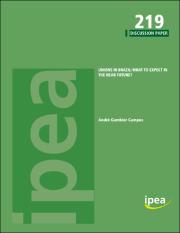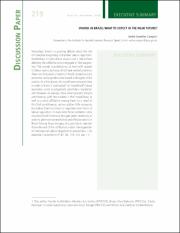Please use this identifier to cite or link to this item:
https://repositorio.ipea.gov.br/handle/11058/7330Full metadata record
| DC Field | Value | Language |
|---|---|---|
| dc.contributor.author | Campos, André Gambier | - |
| dc.coverage.spatial | Brasil | pt_BR |
| dc.date.accessioned | 2016-11-18T18:38:12Z | - |
| dc.date.available | 2016-11-18T18:38:12Z | - |
| dc.date.issued | 2016-11 | - |
| dc.identifier.uri | http://repositorio.ipea.gov.br/handle/11058/7330 | - |
| dc.description.abstract | Hoje em dia, há um debate crescente sobre o papel da negociação coletiva na regulação do trabalho no Brasil. No entanto, é possível discutir uma regulação deste tipo, sem debater os atores coletivos responsáveis por isso? A resposta é provavelmente negativa, ao menos no que diz respeito aos atores de trabalho (sindicatos), que enfrentam vários dilemas. Há milhares de sindicatos no Brasil, distribuídos por todos os setores econômicos, categorias profissionais e regiões do país. À primeira vista, isso pareceria muito promissor para a promoção de qualquer regulação negociada do trabalho. No entanto, como regra, esses sindicatos apresentam uma constituição frágil, com poucos trabalhadores em sua base, bem como uma pequena filiação entre eles. Como resultado desta constituição frágil, esses sindicatos reúnem poucos recursos para negociar coletivamente novas formas de regulação do trabalho. Para superar esses problemas, algumas mudanças estruturais (e históricas) parecem necessárias, a fim de obter sindicatos mais representativos e efetivos no Brasil | pt_BR |
| dc.language.iso | en-US | pt_BR |
| dc.publisher | Instituto de Pesquisa Econômica Aplicada (Ipea) | pt_BR |
| dc.title | Unions in Brazil : what to expect in the near future? | pt_BR |
| dc.title.alternative | Discussion Paper 219 : Unions in Brazil : what to expect in the near future? | pt_BR |
| dc.title.alternative | Uniões no Brasil : o que esperar no futuro próximo? | pt_BR |
| dc.type | Discussion Paper | pt_BR |
| dc.rights.holder | Instituto de Pesquisa Econômica Aplicada (Ipea) | pt_BR |
| dc.source.urlsource | http://www.ipea.gov.br | pt_BR |
| dc.location.country | BR | pt_BR |
| dc.description.physical | 26 p. : il. | pt_BR |
| dc.subject.vcipea | IPEA::Trabalho::Relações de Trabalho::Relações de Trabalho::Sindicatos | pt_BR |
| dc.subject.vcipea | IPEA::Quadro Institucional::Direito. Legislação::Direito conforme a área de Aplicação::Legislação Trabalhista | pt_BR |
| dc.subject.vcipea | IPEA::Trabalho::Relações de Trabalho::Relações de Trabalho::Negociação Coletiva | pt_BR |
| dc.rights.license | Reproduction of this text and the data it contains is allowed as long as the source is cited. Reproductions for commercial purposes are prohibited. | pt_BR |
| dc.subject.keyword | Labour regulation | pt_BR |
| dc.subject.keyword | Collective bargaining | pt_BR |
| dc.subject.keyword | Unions. | pt_BR |
| ipea.description.additionalinformation | Série monográfica: Discussion Paper ; 219 | pt_BR |
| ipea.description.additionalinformation | Possui referências bibliográficas | pt_BR |
| ipea.description.additionalinformation | Possui apêndice | pt_BR |
| ipea.access.type | Acesso Aberto | pt_BR |
| ipea.rights.type | Licença Comum | pt_BR |
| ipea.englishdescription.abstract | Nowadays, there is a growing debate about the role of collective bargaining in Brazilian labour regulation. Nonetheless, is it possible to discuss such a role without debating the collective actors engaged in that bargaining? The answer is probably no, at least with respect to labour actors (unions), which face several problems. There are thousands of unions in Brazil, spread by every economic sector, professional branch and region of the country. At a first glance, this would seem very promising in order to foster a negotiated labour regulation. However, on average, those unions present a fragile constituency, with few workers in their social base, as well as a small affiliation among them. As a result of this frail constituency, unions gather little resources to negotiate new forms of labour regulation. To overcome those problems, some structural (and historical) changes seem necessary, in order to get more representative and effective unions in Brazil. | pt_BR |
| ipea.researchfields | N/A | pt_BR |
| ipea.classification | Emprego. Trabalho | pt_BR |
| Appears in Collections: | Emprego. Trabalho: Livros | |
Files in This Item:
| File | Description | Size | Format | |
|---|---|---|---|---|
| DiscussionPaper_219.pdf | 647.68 kB | Adobe PDF |  View/Open | |
| DiscussionPaper_219_sumex.pdf | 28.43 kB | Adobe PDF |  View/Open |
Items in DSpace are protected by copyright, with all rights reserved, unless otherwise indicated.

